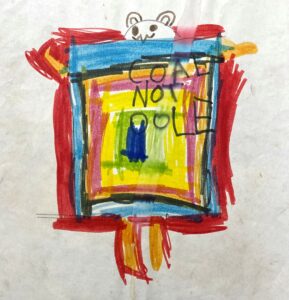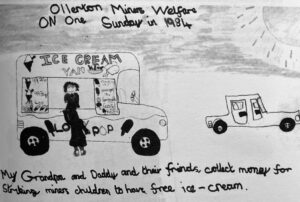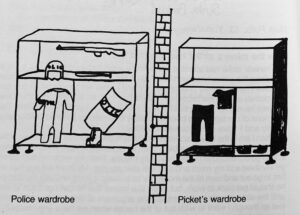
Kids of the Colliery: Remembering the Miner’s Strike Through the Eyes of Children
In this blog post, library volunteer Steph takes a look at some of the archive materials on the strike to explore how it was viewed by the children of mining communities.
March 3, 2025, marks 40 years since the end of the miners’ strike in Britain – an event that remains a defining moment in the nation’s history. But what makes it worth remembering?
The strike has come to symbolise a major turning point in Britain’s political and economic landscape. Under Margaret Thatcher’s Conservative government, the 1980s saw a push toward deregulation and free-market policies, dismantling the democratic-socialist principles that had shaped the postwar era.
While the strike is often remembered in terms of this shift in governance and public ideology, it’s important not to lose sight of the personal experiences of those who lived through it. The struggle was not just political, it was human, marked by the resilience, sacrifice, and solidarity of entire communities in the face of uncertainty.
Kids of the Colliery : Remembering the miner’s strike through children’s eyes
While the miners’ strike is often seen through a political lens, it also profoundly impacted thousands of children. Though their accounts may lack the political complexity found in other sources, children often highlight everyday details that adults overlook, providing an unfiltered glimpse into the emotions and attitudes within their communities.
These examples are just a few of many that highlight how children understood and experienced various aspects and impacts of the strike.

Child’s drawing of a rainbow mining picket reading “Coal Not Dole”.
Life During the Strike
In mining areas, men were often the sole breadwinners of the household, which resultantly left many families without a steady income during the strike. Donations and fundraising helped, but many mining families – already low earners – had to make sacrifices in their daily life. These cutbacks were often felt acutely by children, who lost access to small comforts and luxuries.
“I have not been able to go out as much because I have not had enough money and I have not been able to buy any new clothes or any new records…When I used to go home from school I used to watch the television but now my dad makes me turn it off and tells me that we have got to keep the electricity bills low. That sometimes causes an argument and I blame it on him for being on strike. Really I know that it’s not fair…he doesn’t want to let the miners’ union down.”
– Cheryl Brook, Aged 16, Yorkshire.
While Cheryl understands her Dad’s commitment to the strike, she also resents what she has had to give up. The changes within her home are much more relevant to her personal experience than the changes in British politics, and the strike seems more like a disruption to her routine than it does a pivotal political movement.
“While my dad picketed to stop them closing the pits, I helped my mam at our jumble sales to raise money. We had nice times on our trips with the union to the beach and to parks, and we made lots of new friends…I missed our colour television. We had to watch a black and white set.”
– Nicola Cowan, Aged 8, Northumberland.
Nicola has also felt the impact of certain material sacrifices. However, unlike Cheryl, her involvement in union activities has helped her maintain morale and fostered a newfound enthusiasm for both the strike and her community.
The accounts of both girls reveal the range of emotions felt by strikers and their families. It caused conflict and tension among loved ones, but at the same time many were able to find positive moments to appreciate.
Eight-year-old Susan captures this spirit in her drawing, which shows her father and other miners using some of their fundraising earnings to buy ice-cream for the local children. Small, routine moments like these bring clarity to the past, and remind us that at its core the strike was motivated by a duty of care for family and loved ones.

Drawing of an ice-cream van on a sunny day.
Susan Sandhu, Aged 8, Nottinghamshire.
Mining communities often came together to support one another to lessen their individual struggles. Communal kitchens and cafes were set up to provide free meals to families, and strike centres like the one described by Christopher were established as local hubs where people could share what they had.
“The strike centre is a pleasant place
Where people join to play
And fathers play cards
And have a happy time
And the wives cook meals
For the children and the men.”
Christopher Savage, Aged 9, Nottinghamshire.
Police, Arrests and Violence
Police were positioned at mine entrances to protect the “scabs” who chose to keep working from the strikers who would picket the collieries, but armed presence often escalated existing tensions. Violence, arrests, and hostility created lasting impressions on the children who witnessed them.
“The policemen were pigs I started to think
I’d never hated them so
When they took their truncheons and started to charge
I just wanted them to go.
When dad went on the picket line
Each and every day
I couldn’t wait till he got home
I wanted him to stay.
I didn’t want him going out
In case he might get hurt
I was worried about the violence
The police treated them like dirt.
I hoped he wouldn’t be arrested
I don’t know what I’d have done
But he didn’t and luckily he didn’t get hurt a lot
He’s one in a million.”
Jill Gaskell, Aged 14, Yorkshire.
Jill’s poem reveals a shared fear of miners’ children as their fathers risked injury and arrest. She counts herself as lucky that her dad returned home with only minor injuries, reinforcing the reality that violence had become an expected part of the strike. The hostility she expresses toward the police is informed by this experience of anxiety.

Diary extract.
Joanne, Hunterston, Scotland.
Similarly, the diary of Joanne documents her experience on the night her dad had been arrested. She feels concerned by his later-than-usual absence, and can sense her mother’s unease, it isn’t until the next day that her worries are confirmed.
Both of the girls’ accounts provide insight into how children understood the tensions around them. Despite being young, they were deeply aware of, and affected by, the events unfolding in their communities.
The awareness of children to the hostility of the strike is shown again in Colin’s drawing. Comparing a policeman’s wardrobe to a picket’s, the picture shows how strikers’ children perceived the power dynamics between the police and the miners. Many families felt that the police were there to suppress the cause, and this sentiment shaped how many children viewed the strike and the police.

Drawing of a Police wardrobe vs a Picket’s wardrobe.
Colin Scott, Aged 15, Northumberland.
Political Perceptions
The fierce loyalty many miners felt toward their union was often echoed by their children. Growing up in strike-affected households, children internalised the political rhetoric and strong opinions that surrounded them, sometimes expressing it in ways that were quite assertive for their age.
“Scargill is like a God of the Heavens
Caring for pickets, families, future and mankind
He is a leader and must not be forgotten
He is the saviour for all our pits
Scargill is like a lion, so brave
Seeing the future, who Thatcher delays
He is a man hopeful of winning
The emerald of pickets, the treasure of the future
With Scargill guiding, WE MUST WIN
Scargill lives on.”
– Paul Dove, Aged 13, Nottinghamshire.
Paul’s poem sees Scargill as a hero battling against Thatcher’s policies. Although this good-vs-evil narrative is a common way for children to visualise conflict, the idolisation of Scargill reveals a deep-set loyalty and hopefulness that strikers directed towards the union.
“Arthur Scargill was in the march. We went past Mrs Thatcher’s house and we all booed. When we got to the square we put the banner down and we listened to Arthur.”
– Kirsty Rankin, Aged 7, Yorkshire.
Children often had strong ideas about the key figures involved in the strike. At only seven-years-old, Kirsty was already attending union marches with her family, pointing out Scargill and booing Margaret Thatcher. This is particularly striking, as it shows how even the youngest members of mining families absorbed the collective hostility toward government policies.
Community Divides
Union loyalty didn’t just manifest as projections onto public figures, it also created personal rifts. Strikers often saw those who continued to work – “scabs” – as betraying their communities, and this sentiment was sometimes reflected in the words of their children.
“The scabs I wished I could kill them
And I wished Maggie Thatcher dead
I’ve never wished that on anyone
So I wished it on the scabs instead.
…
We found out two scabs lived down the avenue
I wanted to prove their decision wrong
But someone told me not to worry
‘They’ll not have their windows for long’.”
– Jill Gaskell, Aged 14, Yorkshire.
Jill’s poem is intense, reflecting the anger that circulated mining communities. Her words show how children absorbed the emotional frustrations of the strike, sometimes even expressing feelings of violence that, while extreme, underscore the deep divisions created by the dispute.
“How proud I am to have
A striking miner for a dad.
It really is much better
Than having one who is a scab!
He can always say he fought hard
To keep his job
He didn’t sell his principles
To MacGregor and his mob.”
– Donna Nicholls, Aged 12, Yorkshire.
Similarly to Jill, Donna makes a point to exclude non-striking miners from her praise, but she takes a more principled approach. Her poem reflects a strong sense of moral righteousness, positioning striking as an act of integrity that “scabs” just can’t manage.
Remembering the Strike.
For those interested in learning more about the 1984/85 miners’ strike, the Working Class Movement Library has a vast collection of archival material on the strike, as well as an exhibition that is on until July 2025, so feel free to pop in, or book a reading room appointment to request access to further materials.
Steph Harding
Sources (all part of the library collection):
Hoyles, M. and Hemmings, S. (Eds.). (1985). More Valuable Than Gold: A Collection of Writings on the Miners’ Strike.
Durham Voices. (1985). The Last Coals of Spring: Poems, Stories and Songs.
Lothian Women’s Support Group. (1986). Women Living the Strike.
Unnamed Child’s Drawing. “Coal Not Dole”. Miners Strike Box 4.